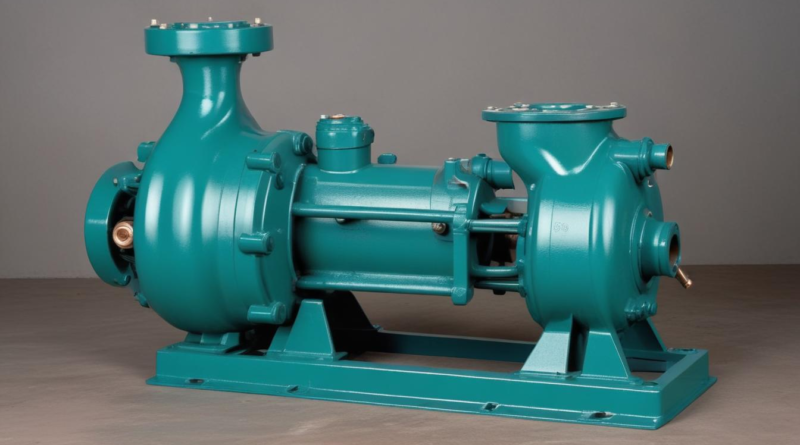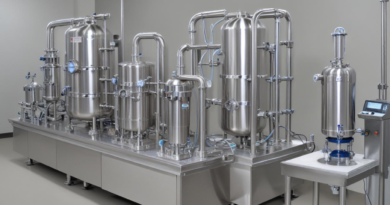understanding centrifugal pumps
Centrifugal pumps operate based on the principle of converting rotational kinetic energy into hydrodynamic energy. As the impeller rotates, it imparts velocity to the fluid, causing it to move radially outward from the center of rotation due to centrifugal force. This increase in fluid velocity is subsequently transformed into pressure energy within the pump volute or diffuser, facilitating the movement of the fluid through the system.
The key stages in the operation of centrifugal pumps include:
- Suction: Fluid enters the pump through the suction port and is directed towards the impeller eye.
- Impeller Action: The rotating impeller accelerates the fluid outward through its vanes.
- Energy Conversion: Kinetic energy from the fluid is converted into pressure energy as the fluid exits the impeller and enters the volute or diffuser.
- Discharge: The pressurized fluid is discharged from the pump, ready for distribution to the desired application.
The efficiency of centrifugal pumps is influenced by several factors, including impeller design, rotational speed, and the properties of the fluid being pumped. Understanding these operational dynamics is crucial for selecting the appropriate type of centrifugal pump tailored to specific applications. Additionally, variations in pump design, such as single-stage versus multi-stage configurations, allow for versatility in handling different flow rates and pressure requirements.
A typical operational flow can be summarized in the following table:
| Stage | Description |
|---|---|
| Suction | Fluid is drawn into the pump through the inlet port. |
| Compression | The impeller accelerates the fluid, increasing its velocity. |
| Conversion | Velocity energy is converted to pressure energy in the volute or diffuser. |
| Discharge | Pressurized fluid exits the pump to the discharge line. |
Understanding these operational principles is essential for optimizing the performance and reliability of centrifugal pumps across various industrial and commercial applications.
Main components
A centrifugal pump consists of several essential components, each playing a crucial role in its overall functionality and efficiency. Understanding these components is fundamental to selecting the right pump for specific applications and ensuring optimal performance throughout its operational lifespan.
- Impeller: The heart of the pump, the impeller is a rotating component with vanes that impart kinetic energy to the fluid. As the impeller spins, it accelerates the fluid outward from the center, creating the necessary flow and pressure.
- Casing (Volute or Diffuser): Surrounding the impeller, the casing collects the fluid discharged by the impeller and converts the velocity energy into pressure energy. There are primarily two types of casings:
- Volute Casing: Features a spiral-shaped chamber that gradually expands, facilitating the conversion of velocity to pressure.
- Diffuser Casing: Comprises stationary vanes that direct and slow down the fluid flow, enhancing pressure development.
- Shaft: The shaft connects the impeller to the driver (such as an electric motor or engine). It must be robust and precisely balanced to handle the rotational forces and prevent excessive vibration.
- Bearings: Located at both ends of the shaft, bearings support the shaft and allow smooth rotation. They are critical for maintaining alignment and reducing friction, thereby extending the pump’s operational life.
- Seals: Seals prevent the leakage of the pumped fluid along the shaft. Types of seals include:
- Mechanical Seals: Provide a reliable barrier between the rotating shaft and stationary casing, suitable for high-pressure applications.
- Stuffing Boxes: Traditional sealing method using packing material, often used in lower-pressure scenarios.
- Couplings: These connect the pump shaft to the driver, allowing for the transfer of rotational motion while accommodating any misalignment or thermal expansion between the two components.
- Mouths (Inlet and Outlet Connections): The inlet (suction) and outlet (discharge) ports facilitate the entry and exit of the fluid. They are typically designed to match standard piping systems for easy integration into larger networks.
- Base or Frame: Provides structural support for all pump components, ensuring stability and alignment during operation. A well-designed base minimizes vibrations and facilitates maintenance activities.
To further illustrate the relationship and functions of these components, consider the following table:
| Component | Function |
|---|---|
| Impeller | Accelerates fluid by imparting kinetic energy through its rotating vanes. |
| Casing | Converts kinetic energy from the impeller into pressure energy for fluid discharge. |
| Shaft | Transfers rotational energy from the driver to the impeller. |
| Bearings | Support the shaft and facilitate smooth rotation with minimal friction. |
| Seals | Prevent fluid leakage along the rotating shaft, maintaining efficiency and safety. |
| Couplings | Connect the pump to the driver, allowing for motion transfer and alignment flexibility. |
| Inlet and Outlet Connections | Enable the entry and exit of fluid, integrating the pump into the broader system. |
| Base or Frame | Provides structural integrity and stability to the pump assembly. |
Each component must be carefully selected and maintained to ensure the pump operates efficiently and reliably. Factors such as the type of fluid, operating conditions, and specific applications will influence the choice of materials and design features for these components. Proper understanding and management of these main components are essential for optimizing the performance and longevity of centrifugal pumps in diverse industrial settings.
Types of centrifugal pumps
Centrifugal pumps come in a variety of types, each tailored to specific applications and operational requirements. Understanding the differences among these types is essential for selecting the most suitable pump for a given task. The primary classifications are based on impeller design, casing configuration, and the number of stages. Below are the most common types of centrifugal pumps:
- Single-Stage Pumps: Equipped with a single impeller, these pumps are ideal for applications requiring moderate pressure and flow rates. They are commonly used in water supply systems, irrigation, and HVAC systems.
- Multi-Stage Pumps: Featuring two or more impellers in series, multi-stage pumps can achieve higher pressure levels. They are suitable for applications such as boiler feedwater, high-rise building water supply, and industrial processes requiring elevated pressure.
- End-Suction Pumps: Characterized by their simple design, end-suction pumps have a single inlet and outlet. They are widely used in water circulation, fire protection systems, and general industrial processes due to their ease of installation and maintenance.
- Split-Case Pumps: These pumps have a casing that splits horizontally, allowing access to internal components for easier maintenance. Split-case pumps are commonly used in large-scale water treatment plants, municipal water supply, and HVAC systems.
- Inline Pumps: With inlet and outlet connections positioned along the pump’s axis, inline pumps are compact and ideal for applications with limited space. They are often used in chemical processing, food and beverage industries, and small-scale water systems.
- Vertical Pumps: Designed with the motor mounted on top, vertical pumps occupy less floor space and are suitable for deep well applications, wastewater treatment, and dewatering operations.
- Horizontal Pumps: Featuring a horizontal shaft orientation, these pumps are preferred for applications where space is not a constraint. They are extensively used in power plants, oil and gas industries, and large-scale manufacturing facilities.
- Magnetic Drive Pumps: Utilizing a magnetic coupling to transfer torque from the motor to the impeller, magnetic drive pumps eliminate the need for seals, reducing the risk of leakage. They are ideal for handling hazardous or corrosive fluids in chemical processing and pharmaceutical industries.
To further illustrate the differences among these types, consider the following comparison table:
| Type | Key Features | Typical Applications |
|---|---|---|
| Single-Stage | One impeller, moderate pressure and flow | Water supply, irrigation, HVAC systems |
| Multi-Stage | Multiple impellers, higher pressure | Boiler feedwater, high-rise buildings, industrial processes |
| End-Suction | Simple design, single inlet and outlet | Water circulation, fire protection, general industrial use |
| Split-Case | Horizontally split casing, easy maintenance | Water treatment plants, municipal supply, HVAC systems |
| Inline | Axial inlet and outlet, compact | Chemical processing, food and beverage, small-scale systems |
| Vertical | Motor mounted on top, space-efficient | Deep wells, wastewater treatment, dewatering |
| Horizontal | Horizontal shaft, space not constrained | Power plants, oil and gas, large manufacturing |
| Magnetic Drive | No seals, reduces leakage risk | Handling hazardous or corrosive fluids, chemical and pharmaceutical |
Selecting the appropriate type of centrifugal pump involves evaluating factors such as the required flow rate, head (pressure), fluid characteristics, and installation space. For instance, single-stage pumps are preferable for applications with lower pressure needs, while multi-stage pumps are essential for high-pressure requirements. Similarly, magnetic drive pumps are chosen for their leak-free operation in handling hazardous fluids. By carefully analyzing these aspects, engineers and technicians can ensure optimal performance and longevity of the pump within its intended applications.
Performance characteristics
 Performance characteristics of centrifugal pumps are critical in determining their suitability for specific applications and ensuring optimal operational efficiency. These characteristics encompass various parameters that define how the pump performs under different conditions, including flow rate, head, efficiency, power consumption, and Net Positive Suction Head (NPSH). Understanding these factors is essential for selecting the right centrifugal pump and for troubleshooting performance issues.
Performance characteristics of centrifugal pumps are critical in determining their suitability for specific applications and ensuring optimal operational efficiency. These characteristics encompass various parameters that define how the pump performs under different conditions, including flow rate, head, efficiency, power consumption, and Net Positive Suction Head (NPSH). Understanding these factors is essential for selecting the right centrifugal pump and for troubleshooting performance issues.
One of the primary performance metrics is the flow rate, which measures the volume of fluid the pump can deliver over a specific period, typically expressed in gallons per minute (GPM) or cubic meters per hour (m³/h). The flow rate must align with the system’s requirements to ensure adequate fluid supply without excessive energy consumption.
Head refers to the pressure the pump generates to move the fluid, usually measured in feet or meters of liquid. It indicates the pump’s ability to overcome the resistance within the system, including friction losses in pipes and elevation differences. The combination of flow rate and head determines the overall performance and suitability of the pump for a given application.
Efficiency is a measure of how effectively the pump converts electrical or mechanical energy into hydraulic energy. High-efficiency pumps reduce energy costs and operational expenses. Efficiency can vary based on the design of the impeller, the speed of rotation, and the fluid properties. Manufacturers often provide efficiency curves that show the pump’s performance across different operating points.
Power consumption is another crucial characteristic, representing the amount of energy required to operate the pump. It is influenced by factors such as flow rate, head, and pump efficiency. Accurate power calculations are necessary to ensure that the power supply can handle the pump’s demands and to optimize energy usage.
Net Positive Suction Head (NPSH) is a vital parameter that prevents cavitation, a condition where vapor bubbles form in the fluid due to low pressure, potentially causing damage to the pump. NPSH Available (NPSHA) must be greater than NPSH Required (NPSHR) to maintain stable pump operation and prolong its lifespan.
The relationship between these performance characteristics is typically illustrated using pump performance curves, which graphically represent the pump’s behavior under various conditions. These curves include:
- Flow vs. Head Curve: Shows the relationship between the flow rate and the head generated by the pump. It helps in identifying the operating point where the desired flow and head intersect.
- Efficiency Curve: Indicates the pump’s efficiency at different flow rates, allowing for the selection of pumps that operate near their peak efficiency point.
- Power Curve: Displays the power consumption corresponding to different flow rates, aiding in energy management and cost estimation.
- NPSH Curve: Demonstrates the NPSHR required at various flow rates, ensuring that the system provides sufficient NPSHA to avoid cavitation.
A comprehensive understanding of these curves enables engineers to make informed decisions regarding pump selection, system design, and operational adjustments. For instance, operating a pump far from its best efficiency point can lead to increased energy consumption and premature wear, while ensuring adequate NPSH can prevent costly maintenance and downtime caused by cavitation.
The following table summarizes the key performance characteristics of centrifugal pumps:
| Performance Characteristic | Description | Units |
|---|---|---|
| Flow Rate | Volume of fluid delivered per unit time | GPM, m³/h |
| Head | Pressure generated to move the fluid | Feet, Meters |
| Efficiency | Ratio of hydraulic power to input power | % |
| Power Consumption | Energy required to operate the pump | Horsepower (HP), Kilowatts (kW) |
| NPSH | Net Positive Suction Head to prevent cavitation | Feet, Meters |
In addition to these basic characteristics, other factors such as pump speed, viscosity of the fluid, and system resistance also influence pump performance. The affinity laws provide a mathematical relationship between these variables, allowing for the prediction of pump performance changes when speed, diameter, or other factors are altered. These laws are essential for scaling pump operations and adjusting to varying applications without significant redesign.
- First Affinity Law: Relates flow rate to the pump speed and impeller diameter. If the speed is doubled, the flow rate also doubles.
- Second Affinity Law: Connects head to the square of the pump speed or impeller diameter. Increasing the speed by a factor of two results in a fourfold increase in head.
- Third Affinity Law: Links power consumption to the cube of the pump speed or impeller diameter. Doubling the speed leads to an eightfold increase in power required.
Proper application of the affinity laws aids in optimizing pump selection and operation, ensuring that centrifugal pumps deliver the required performance efficiently across different applications.
In summary, understanding the performance characteristics of centrifugal pumps is fundamental for selecting the appropriate pump type, designing efficient systems, and achieving reliable operation. Engineers must carefully analyze flow rate, head, efficiency, power consumption, and NPSH in conjunction with pump performance curves and affinity laws to ensure that the selected pump meets the specific needs of its intended application while maximizing energy efficiency and operational longevity.
Applications and selection
Centrifugal pumps are integral to a wide range of industries and processes, serving as the backbone for fluid transfer in numerous applications. Their versatility, reliability, and efficiency make them suitable for both simple and complex systems. Understanding the specific applications and the criteria for selecting the appropriate pump type is crucial for optimizing performance and ensuring system longevity.
Industrial Applications:
- Water and Wastewater Treatment: Centrifugal pumps are used to transport water through treatment facilities, facilitating processes such as filtration, sedimentation, and chemical dosing.
- Oil and Gas: Employed in the extraction, transportation, and refining stages, these pumps handle crude oil, natural gas liquids, and other hydrocarbons.
- Chemical Processing: Handling a variety of corrosive and viscous fluids, centrifugal pumps play a vital role in mixing, reacting, and transferring chemicals.
- Power Generation: Used in cooling systems, boiler feedwater circuits, and other critical processes within power plants.
- Food and Beverage: Ensuring sanitary conditions, these pumps transfer liquids like milk, juices, and sauces without contamination.
Commercial Applications:
- HVAC Systems: Circulating water or glycol mixtures for heating and cooling buildings, maintaining comfortable indoor environments.
- Fire Protection Systems: Delivering water at high pressures to fire suppression systems, ensuring rapid response in emergencies.
- Irrigation: Facilitating the distribution of water in agricultural settings, supporting crop growth and sustainability.
Residential Applications:
- Domestic Water Supply: Providing consistent water pressure for household needs, including drinking, cooking, and sanitation.
- Dewatering: Removing excess water from basements, construction sites, or flooded areas to prevent damage and maintain dry conditions.
Selecting the appropriate centrifugal pump involves a systematic evaluation of several factors to ensure compatibility with the intended application. The primary considerations include:
- Flow Rate and Head Requirements: Determining the necessary volume of fluid to be moved and the pressure required to overcome system resistance.
- Fluid Characteristics: Analyzing properties such as viscosity, temperature, corrosiveness, and the presence of solids or abrasives to select materials and pump types that can handle these conditions.
- Installation Environment: Considering spatial constraints, environmental conditions, and accessibility for maintenance.
- Energy Efficiency: Evaluating the pump’s efficiency to minimize operational costs and reduce energy consumption.
- Maintenance and Reliability: Assessing the ease of maintenance, availability of spare parts, and the pump’s track record for reliability in similar applications.
- Budget Constraints: Balancing upfront costs with long-term operational expenses to achieve the best value.
The following table outlines common applications alongside the most suitable types of centrifugal pumps:
| Application | Suitable Pump Types | Key Considerations |
|---|---|---|
| Water Supply and Distribution | End-Suction, Split-Case, Inline | High reliability, easy maintenance, suitable for moderate head and flow requirements. |
| Wastewater Treatment | Multi-Stage, Vertical, Magnetic Drive | Corrosion-resistant materials, ability to handle solids, high head requirements. |
| Oil and Gas Operations | Magnetic Drive, Multi-Stage, Horizontal | Handling viscous fluids, leak-free designs, high pressure and flow rates. |
| Chemical Processing | Magnetic Drive, Inline, Vertical | Corrosive fluid compatibility, precise flow control, safety features to prevent leaks. |
| HVAC Systems | End-Suction, Inline, Vertical | Energy efficiency, compact design, quiet operation. |
| Fire Protection | End-Suction, Split-Case | High reliability, rapid response capability, compliance with safety standards. |
| Agricultural Irrigation | Inline, End-Suction, Split-Case | Durability, ease of installation, ability to handle varying flow rates. |
| Residential Water Systems | Single-Stage, End-Suction | Compact size, energy-efficient operation, quiet performance. |
In addition to identifying the suitable pump type, it is essential to consider the system integration aspects. Proper sizing ensures that the pump operates within its optimal efficiency range, preventing issues such as cavitation, excessive wear, or energy wastage. System designers often use hydraulic calculations and performance curves to match the pump’s capabilities with the system’s demands.
Case Studies:
- Municipal Water Treatment: A city’s water treatment facility required a reliable pump system to handle varying flow rates throughout the day. By selecting multi-stage split-case centrifugal pumps, the facility achieved the necessary head and flow rates while maintaining energy efficiency and ease of maintenance.
- Industrial Chemical Plant: An chemical processing plant needed a leak-proof pump to handle corrosive fluids. Magnetic drive centrifugal pumps were chosen to eliminate seals, thereby reducing the risk of leaks and enhancing safety.
- High-Rise Building Water Supply: A new high-rise development required pumps capable of delivering water to upper floors with adequate pressure. Multi-stage vertical centrifugal pumps were installed to provide the necessary head while occupying minimal floor space.
By analyzing specific applications and understanding the operational requirements, engineers and technicians can make informed decisions when selecting centrifugal pumps. This ensures not only the efficiency and reliability of the pumping system but also contributes to the overall sustainability and cost-effectiveness of the operations.




